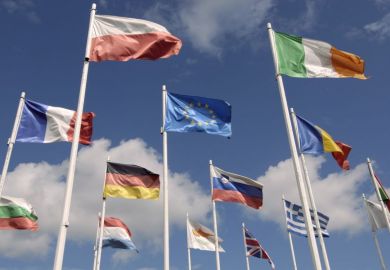While the European Union has surprised many by maintaining a united front in Brexit negotiations, it is commonly argued that the Covid-19 crisis has once again exposed cracks in the multinational bloc.
Member states did form a consortium to buy medical supplies – which the UK government failed to join out of either abject incompetence or raw ideology, depending on how plausible you regard its claim that the invitation went to the wrong email address. However, member states’ disparate lockdown policies and their wrangling over how to pay for them suggests that the nation state remains the emphatic locus of European politics and identity.
Among those calling for greater coordination, unsurprisingly, has been French president Emmanuel Macron. Macron has styled himself as one of the few remaining champions of the European project in an age of national populism. And in one of his first major speeches as president, at Paris’ Sorbonne University in 2017, he pinpointed universities as key to forging a stronger common European identity.
Specifically, Macron advocated the creation of pan-continental consortia of universities whose students and staff would move seamlessly between their campuses, steeping themselves in each country’s culture and language (and, presumably, drawing out the common European threads in the process).
The European Commission acted uncharacteristically quickly on the suggestion. Late last year, it unveiled 17 “European universities”, consisting of 114 institutions. Up to 24 more are due to be designated later this year.
But how much substance is there behind the rhetorical aspiration? This is the issue addressed by our cover feature. One question is how much coordination there will really be between the institutions involved. While at least some of them insist that they are serious about integration, history is littered with examples of supposedly game-changing tie-ups that ultimately come to little.
But even if, say, Heidelberg University ultimately adopts the distinctly unmelodious name of “4EU+, Heidelberg”, there is still a question about whether a relatively small number of such managerially unified networks will really be effective anecdotes to populism. Quite apart from the coronavirus’ short-term block on international movement, there must be a concern – as set out in our feature by Florian Stoeckel, a politics lecturer at the University of Exeter – that the appeal of European Universities will be strongest among those students most convinced of their European identities already.
The paucity of British universities involved might be expected in the political circumstances and might matter little given that the Brexit horse has already bolted. But the Brexit demographics are important. Analysis suggests that 64 per cent of over-65s and 70 per cent of those who left school at 16 voted for Brexit, compared with just 29 per cent of under-25s and 32 per cent of those with a degree. This suggests that it is elderly carpet-fitters, not young would-be lawyers, who need convincing of the EU’s value.
Still, there are doubtless other advantages offered by the scheme, and even commission insiders suggest that its purpose has shifted towards piloting new commission policies for education and research. There is certainly a need for the commission to come up with some new policy ideas if the so-called European Research Area (ERA) – characterised by research collaboration, researcher mobility and common research infrastructure – is ever to be fully implemented. As noted by Jan Palmowski, secretary general of the Guild of European Research-Intensive Universities, in a blog earlier this week, the idea is decades old, but progress on realising it has been “partial at best”.
Palmowski observes that Mariya Gabriel, the new European commissioner for digital economy and society, aims to renew the push to set common European objectives for research. But the central pillar of any pan-continental research area is surely the research funding provided by the EU. And agreement is still lacking on the budget of the next multi-annual framework programme as its January commencement date begins to loom.
Even before Covid-19 struck, there was considerable wrangling over the size of the research budget and the terms of its distribution. The fear must now be that the proposed budget of €84 billion (£71 billion) will be slashed in light of the black hole in national budgets caused by the virus.
But this would clearly be a mistake. Universities are likely to be among the sectors that suffer most in the coming months – at least in those countries most reliant on international students. But, more than that, it would seem foolish to address an economic malaise by choking off an important potential source of future economic growth. (This is also a question for the UK government, of course: will its pledged doubling of research spending, as part of a post-Brexit industrial strategy, still stand post-lockdown?)
According to Palmowski, the ERA was first proposed by the German-British sociologist and politician Ralf Dahrendorf in 1973 with the aim of boosting Europe’s industrial competitiveness and quality of life. But if it is demonstrably able to deliver those benefits in troubled coming years, it might just do much more for the cause of European identity and unity than any number of university networks.
POSTSCRIPT:
Print headline: Bloc building blues
Register to continue
Why register?
- Registration is free and only takes a moment
- Once registered, you can read 3 articles a month
- Sign up for our newsletter
Subscribe
Or subscribe for unlimited access to:
- Unlimited access to news, views, insights & reviews
- Digital editions
- Digital access to THE’s university and college rankings analysis
Already registered or a current subscriber?







